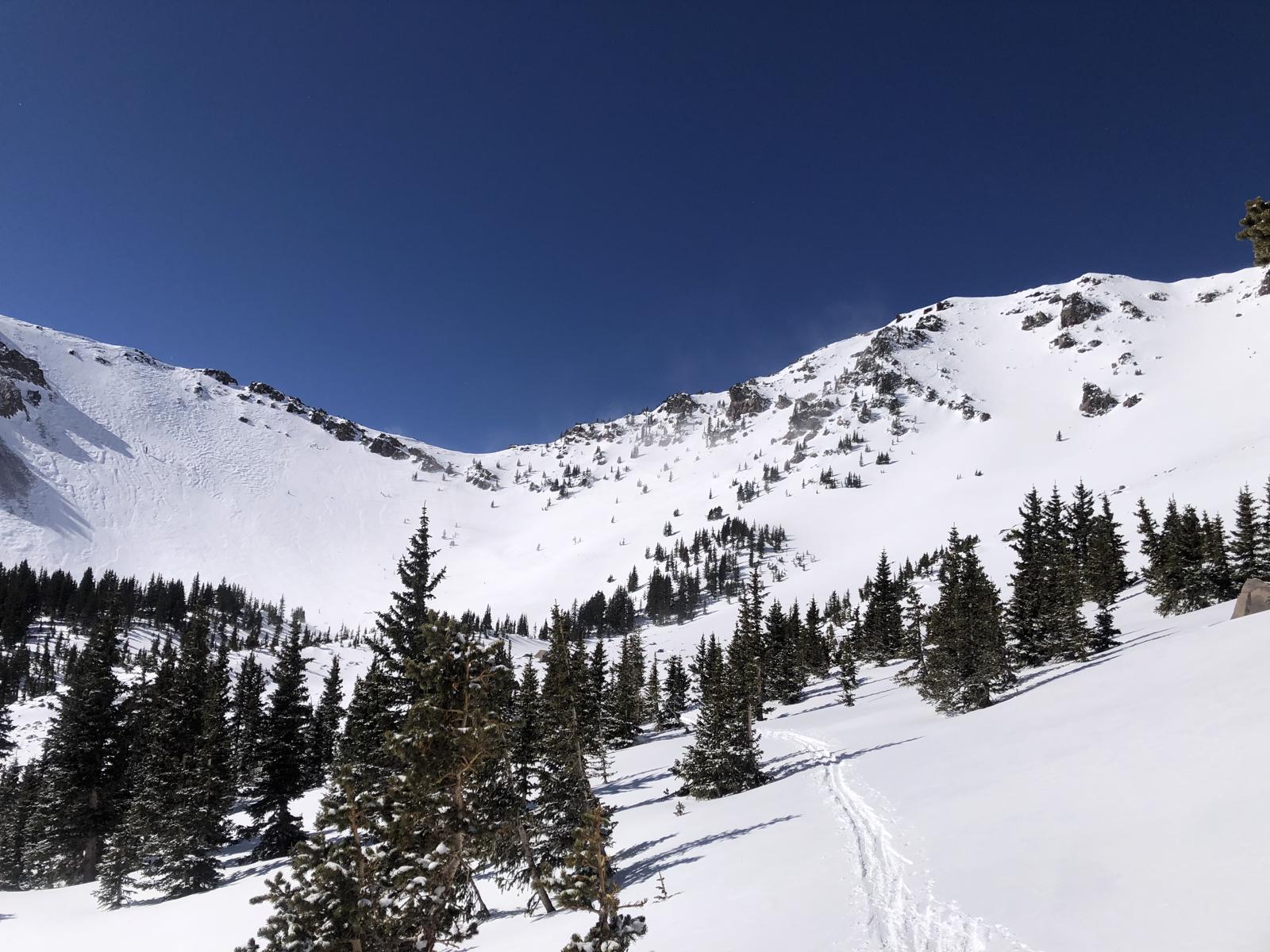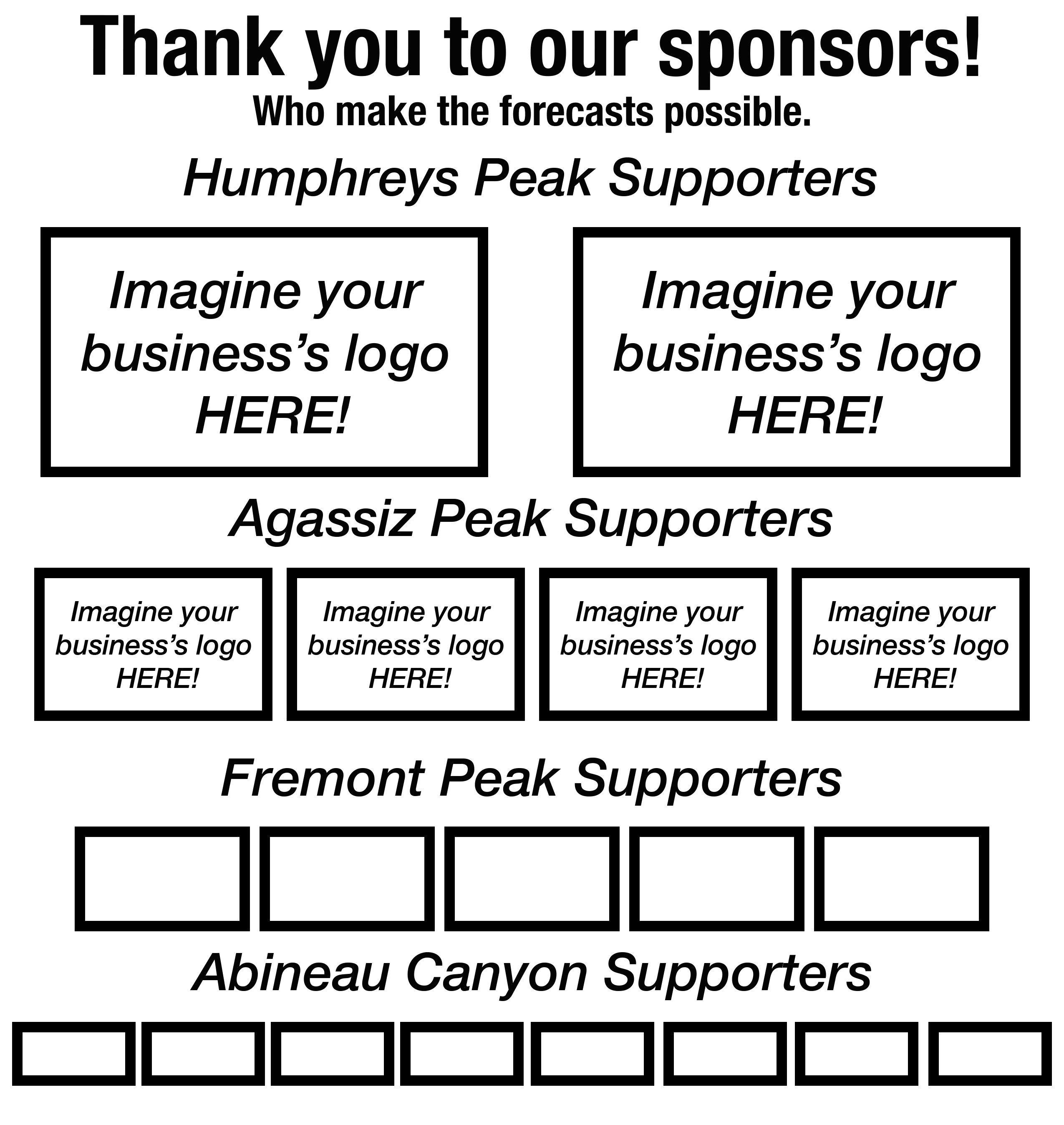Snowpack Summary for Friday, February 26, 2021 1:51 PM Small Storms but More Springtime Conditions Ahead
This summary expired Feb. 28, 2021 1:51 PM
Flagstaff, Arizona - Backcountry of The San Francisco Peaks and Kachina Peaks Wilderness
This summary is generously sponsored by Peace Surplus. Voted best outdoor shop 10 years straight, by the people of Flagstaff and the Arizona Daily Sun.

Overall
Dry, windy and sunny conditions characterized the week. It’s been nearly 14 days since the Valentine’s storm and since any significant accumulation; but a small disturbance will hit the San Francisco Peaks on Sunday. Currently natural and human caused avalanches are unlikely, but the forthcoming storm could bring a small chance of isolated wind slab problem depending on precipitation levels. See more under weather.
Skiing across the peaks is highly variable. If you can find the snow, south facing slopes have been in a melt/freeze cycle, while other aspects may be wind-blown or sun crusted. Wind deposited snow was still being found throughout the week on leeward aspects, while exposed slopes above treeline are very firm. An ice axe may be a valuable safety option, or ski pole/axe combination.
Hazardous conditions continue across other forecast zones and February of 2021 will unfortunately go down as one of the deadliest months in avalanche history. See additional under "more."
Interesting data related to the February avalanche fatalities show that many victims were essentially skiing solo. Either they were alone or their partners were not in a situation to perform an effective rescue.
For more information and accident details see https://avalanche.org/avalanche-accidents/
Near and Above TreelineMuch of the southerly and westerly slopes are scoured to rock. On south facing slopes snow is nearly absent. Although access requires caution, and possibly crampons, snow depths on north and easterly slopes are well over a meter in numerous locations.
Weak layers continue to be present beneath the Valentine’s storm and could be reactive at specific trigger points. Wind deposited snow was reported throughout the inner basin during the week. Although reactivity was low, Sunday's storm could deposit additional snow on leeward sides of ridges and in gullies creating pockets of avalanche prone wind slab.
Below TreelineWatch for obstacles amongst the trees. Northerly and easterly slopes could be used to access upper elevations but even in these areas caution is warranted. Much of the south and westerly slopes are down to patchy snow.
Current Problems (noninclusive) more info

Sunday’s storm will likely be accompanied by enough wind to transport snow on ridgelines at and above tree line elevations. Although it is currently forecasted as a dry storm, if as little as 2 to 3 inches of snow materialize, this accompanied with optimal wind transport, could result in isolated wind slabs.

As temperatures increase this week, south facing slopes, or any slope that does not experience freezing temperatures, may become saturated and unstable.
 expand image
expand image
 expand image
expand image
There is ample snowpack at higher elevations, particularly on the eastern and northern aspects of the Agassiz to Humphrey's Peak ridgeline and Abineau Canyon. Spring conditions can occur though it is still technically winter.
Images

Base of Humphrey's Cirque/Core Ridge looking west. Photo Credit: Tanner Porter 2.21.21

Snowslide Canyon (east aspect of Agassiz Peak) with the Humphrey's Cirque in the background. 2-24-21 Derik Spice
Final Thoughts
Always carry the 10 essentials and avalanche rescue gear for wintertime wilderness travel. Submit your observations here.
For AZ Snowbowl uphill access updates, please refer to snowbowl.ski and flagstaffuphill.com. Expect uphill closures during and shortly after large storm events.
Thank you to our generous sponsors for supporting the Kachina Peaks Avalanche Center!
Weather
Weather updated Thursday February 25
Although cold temperatures remain, conditions are beginning to beckon the coming of Spring. This will change briefly on Sunday when a low enters the region dropping daily highs as much as 15 degrees and bringing a slight chance of precipitation. Although amounts are uncertain, this system appears to be dry and accumulation of more than an inch or two is not anticipated. Temperatures will likely rebound quickly. By mid-week another system approaches the region, yet it too may bring little to no snow accumulation. Temperatures during this storm will be warm and this trend will continue into later in the week.
Snowslide SNOTEL reports 34" (86 cm) of snow at 9,730' on Thursday, February 26 down from a maximum of 51" (130 cm) on January 29th. Since Friday, February 12 Snowslide SNOTEL low temperatures have ranged between 6°F on February 17, to 28°F on February 24, while highs have ranged from 32°F on February 18 to 49°F on February 19. For the same period, ASBTP (11,555') reported a minimum of 1°F on February 18, and a maximum temperature of 43°F on February 22.
So far this winter we have had a total of 128" (325cm) of snowfall at 10,800 feet, with a 40" (107 cm) undisturbed settled base depth reported by Arizona Snowbowl on February 26.
Authored/Edited By: Mathieu Brown, Derik Spice







